How to use a Victor rat trap
Where to put your trap
Start where you have seen rats or where they are likely to be active, such as near rubbish and compost bins.
Rats tend to avoid open areas and prefer cover. You may have more success by putting your trap in a sheltered area or along a fence line, hedge or building.
Ensure the ground is stable and flat, and check to make sure vegetation isn’t blocking the back or front grates.
What to use as bait
Rodents love energy-rich foods high in fat and sugar. Try using peanut butter, cheese, chocolate, hazelnut spread, jam, or nuts (such as almonds, peanuts or walnuts). Animal fat such as bits of bacon fat are another option.
Rats are naturally suspicious of new food sources. You can bait your trap then leave it unset for a few days to help them associate the trap as a good food source. Put some free bait at the entrance of the trap to invite them in.
If you aren’t getting catches in your trap, experiment using different types of baits.
How to set your trap
Fill the ‘bait trough’ on the yellow treadle plate with your chosen bait.
Move the arm bar to the rear of the trap then pull the kill bar back and hold down with your thumbs.
Bring the arm bar back over the kill bar and hook it under the treadle plate.
Lift the treadle plate up slightly with your finger and slowly release your thumb from the kill bar until the arm bar holds in place.
To unset the trap, hold down the kill bar with your thumb and pull the trigger arm out from under the treadle. Slowly release the kill arm while keeping your fingers out of the way.
Here’s how you can dispose of carcasses:
Bury in the garden
Put in your compost bin
Double-bag and place in your Dunedin City Council rubbish bags.
Adjusting trap sensitivity
The arm bar can be placed on the left (firm) or right (sensitive) of the bait trough. The sensitive setting allows the trap to trigger more easily.
Reporting your results
Please let us know what you catch by using the Trap.NZ mobile app or website. This allows us to keep track of the collective effort to protect native wildlife across Dunedin.
To find out more about adding catches, have a look at our guide to using Trap.NZ
Safety information
It’s safest to unset your trap before handling it.
Always wear gloves when handling your trap and wash your hands thoroughly. This minimises the risk of catching animal-borne diseases such as leptospirosis.
Keep your trap inside the wooden trap box provided to keep pets, children and non-target animals safe.
The Victor trap has been humane tested against the National Animal Welfare Advisory Committee (NAWAC) guidelines for Norway rats and ship rats.
Fixing the trigger arm
A common maintenance issue for Victor rat traps is the trigger arm and back staple popping off. Here’s how to fix it.
Use a hammer to gently tap in a new staple at the back of the trap (you'll see two tiny holes from the original staple)
Prise open the hook end of the trigger arm so you can slip it onto the staple (make sure you don't put the trigger arm on upside down!)
Use pliers to squeeze the hook tightly shut so the arm won't pop off again
Test setting the trap to ensure the arm holds under the trigger plate alright
Tips and tricks
Rebait your trap at least once a week
Remove all old bait and any blood/fur from the trap each time you service it
Don’t wash your trap with chemicals or detergents. Water and an old brush will do the trick.
Scuff the entrance to the trap box to create a little pathway for pests
Slugs and insects like to snack on bait and can clean out the trap overnight. Mice are sometimes too light to trigger the trap and may also be responsible for bait theft
Offer pests some free bait on the doorstep of the trap box to lure them in
Move your trap to a new location if you aren’t getting catches





